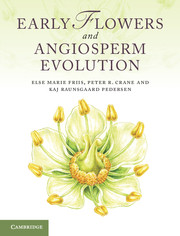Book contents
- Frontmatter
- Contents
- Preface
- 1 Introduction to angiosperms
- 2 The nature of the angiosperm fossil record
- 3 The environmental context of early angiosperm evolution
- 4 Stratigraphic framework and key areas for Cretaceous angiosperms
- 5 Angiosperms in context: extant and fossil seed plants
- 6 Origin and age of angiosperms
- 7 Phylogenetic framework and the assignment of fossils to extant groups
- 8 Fossils near the base of the angiosperm tree
- 9 Early fossil angiosperms of uncertain relationships
- 10 Early fossils of eumagnoliids
- 11 Fossils of monocots
- 12 Fossils of eudicots: early-diverging groups
- 13 Fossils of core eudicots: basal lineages
- 14 Fossils of core eudicots: rosids
- 15 Early fossils of eudicots: asterids
- 16 Patterns of structural diversification in angiosperm reproductive organs
- 17 History and evolution of pollination in angiosperms
- 18 History and evolution of dispersal in angiosperms
- 19 Vegetational context of early angiosperm diversification
- 20 The accumulation of angiosperm diversity
- References
- Index
1 - Introduction to angiosperms
Published online by Cambridge University Press: 07 September 2011
- Frontmatter
- Contents
- Preface
- 1 Introduction to angiosperms
- 2 The nature of the angiosperm fossil record
- 3 The environmental context of early angiosperm evolution
- 4 Stratigraphic framework and key areas for Cretaceous angiosperms
- 5 Angiosperms in context: extant and fossil seed plants
- 6 Origin and age of angiosperms
- 7 Phylogenetic framework and the assignment of fossils to extant groups
- 8 Fossils near the base of the angiosperm tree
- 9 Early fossil angiosperms of uncertain relationships
- 10 Early fossils of eumagnoliids
- 11 Fossils of monocots
- 12 Fossils of eudicots: early-diverging groups
- 13 Fossils of core eudicots: basal lineages
- 14 Fossils of core eudicots: rosids
- 15 Early fossils of eudicots: asterids
- 16 Patterns of structural diversification in angiosperm reproductive organs
- 17 History and evolution of pollination in angiosperms
- 18 History and evolution of dispersal in angiosperms
- 19 Vegetational context of early angiosperm diversification
- 20 The accumulation of angiosperm diversity
- References
- Index
Summary
The phylogenetic diversification and ecological radiation of angiosperms (flowering plants) that took place in the Early Cretaceous, between about 135 and 65 million years ago, was one of the major biotic upheavals in the history of life. It had dramatic consequences for the composition and subsequent evolution of terrestrial ecosystems. Ancient Mesozoic vegetation, which was dominated by ferns, conifers, ginkgos and cycads, as well as Bennettitales and other groups of extinct seed plants, was eventually almost entirely replaced by more modern ecosystems dominated by angiosperms. Since the Early Cretaceous, high diversification rates have generated more than 350 000 extant angiosperm species. Today there are more living species of angiosperms than all other groups of land plants combined.
In their rise to ecological dominance angiosperms have exhibited extraordinary developmental and evolutionary plasticity. This has resulted in overwhelming morphological diversity and a great variety of adaptive types. Angiosperms are far more diverse in vegetative form and in the structure of their reproductive organs than any other group of land plants.
- Type
- Chapter
- Information
- Early Flowers and Angiosperm Evolution , pp. 1 - 22Publisher: Cambridge University PressPrint publication year: 2011
- 3
- Cited by



